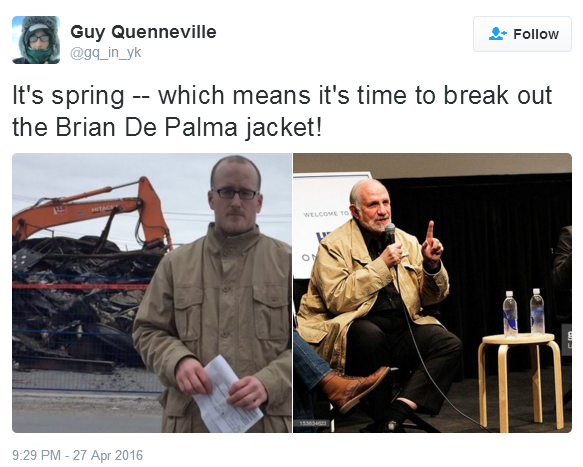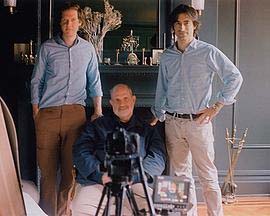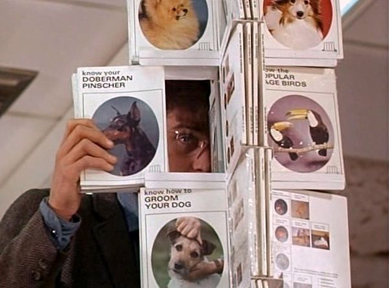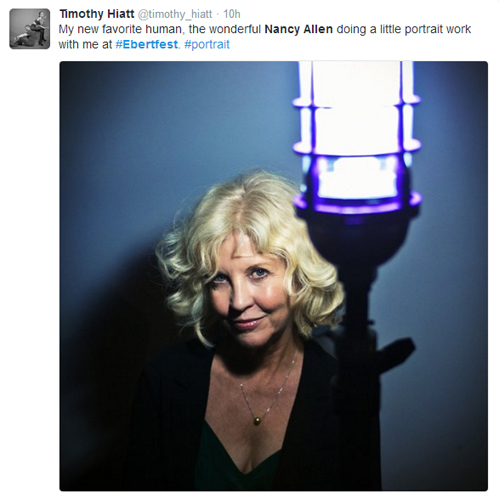
Updated: Wednesday, April 27, 2016 11:52 PM CDT
Post Comment | Permalink | Share This Post
 Hello and welcome to the unofficial Brian De Palma website. Here is the latest news: |
|---|
E-mail
Geoffsongs@aol.com
-------------
Recent Headlines
a la Mod:
Listen to
Donaggio's full score
for Domino online
De Palma/Lehman
rapport at work
in Snakes
De Palma/Lehman
next novel is Terry
De Palma developing
Catch And Kill,
"a horror movie
based on real things
that have happened
in the news"
Supercut video
of De Palma's films
edited by Carl Rodrigue
Washington Post
review of Keesey book
-------------
Exclusive Passion
Interviews:
Brian De Palma
Karoline Herfurth
Leila Rozario
------------
------------
| « | April 2016 | » | ||||
| S | M | T | W | T | F | S |
| 1 | 2 | |||||
| 3 | 4 | 5 | 6 | 7 | 8 | 9 |
| 10 | 11 | 12 | 13 | 14 | 15 | 16 |
| 17 | 18 | 19 | 20 | 21 | 22 | 23 |
| 24 | 25 | 26 | 27 | 28 | 29 | 30 |
De Palma interviewed
in Paris 2002
De Palma discusses
The Black Dahlia 2006

Enthusiasms...
Alfred Hitchcock
The Master Of Suspense
Sergio Leone
and the Infield
Fly Rule
The Filmmaker Who
Came In From The Cold
Jim Emerson on
Greetings & Hi, Mom!
Scarface: Make Way
For The Bad Guy
Deborah Shelton
Official Web Site
Welcome to the
Offices of Death Records

 The Imagine Film Festival, which focuses on horror and sci-fi genre films with an increased interest in thrillers of late, has included screenings of De Palma this year. The third and final screening happens tomorrow, April 24th, the last day of the festival, which began April 14th. The fest's page for the film includes a quote of something Brian De Palma says to Noah Baumbach and Jake Paltrow at one point: "You start with character and work your way outwards, while I start with construction and work my way in."
The Imagine Film Festival, which focuses on horror and sci-fi genre films with an increased interest in thrillers of late, has included screenings of De Palma this year. The third and final screening happens tomorrow, April 24th, the last day of the festival, which began April 14th. The fest's page for the film includes a quote of something Brian De Palma says to Noah Baumbach and Jake Paltrow at one point: "You start with character and work your way outwards, while I start with construction and work my way in."
 Doug Kraner, the production designer on Raising Cain, died on April 4 at the age of 65, according to Variety's Maria Cavassuto, who adds that Kraner had been battling cancer and died in West Hollywood, California.
Doug Kraner, the production designer on Raising Cain, died on April 4 at the age of 65, according to Variety's Maria Cavassuto, who adds that Kraner had been battling cancer and died in West Hollywood, California.
 Sophia Takal's Always Shine (the followup to her 2011 debut, Green) had its world premiere at the Tribeca Film Festival last week. "The early reviews have been positive," states Tasha Robinson at The Verge, "and occasionally rapturous. Like Green, Always Shine deals with jealousy and competition between two women. But where Green is a loose mumblecore drama, Always Shine is a nervy thriller that owes as much to Single White Female as it does to deliberate touchstones like Ingmar Bergman’s Persona."
Sophia Takal's Always Shine (the followup to her 2011 debut, Green) had its world premiere at the Tribeca Film Festival last week. "The early reviews have been positive," states Tasha Robinson at The Verge, "and occasionally rapturous. Like Green, Always Shine deals with jealousy and competition between two women. But where Green is a loose mumblecore drama, Always Shine is a nervy thriller that owes as much to Single White Female as it does to deliberate touchstones like Ingmar Bergman’s Persona."Going back to Robinson's article at The Verge-- she interviews Takal, at one point asking about her influences:
You’ve cited Ingmar Bergman’s Persona, John Cassavetes’ A Woman Under The Influence, and Lynn Ramsay’s Morvern Callar as major influences on this film. What did these films bring to the table?All the movies from the 1970s with slow zooms were visual influences. With my director of photography, Mark Schwartzbard, we watched Robert Altman’s 3 Women and Images, and I really wanted to build suspense through slow zooms and a moving camera like he does. Theme-wise, 3 Women was also a big influence, as was Cassavetes’ Opening Night. The idea of the ghost that becomes more and more threatening to Gena Rowlands’ character was something we wanted to incorporate. And with Morvern Callar — Larry showed me that movie, because a lot of the feedback we were getting from traditional financiers, when we were trying to make this movie in a more traditional way, was that the main character wasn’t likable, and it was unclear why she was doing these things. Larry said, "There’s this great movie you need to see, where the protagonist’s motivations aren’t really explained in a way where everything ties up neatly, and with a character who’s flawed." That really opened things up for me.
I don’t know if this is true, but I feel like female directors are better able to understand the complexity of a female character without needing to explain everything, and without needing to make the character "likable." Likability to me is such a frustrating thing. I think there’s more awareness around this now, but in general, male characters can be so flawed, but if a woman is mildly annoying, "She’s not likable!" It mirrors this box of femininity in the real world, too, where you have to be this one narrow, certain way, and if you’re not, you’re intolerable.
Who do you consider the main character? One of the interesting things about the film is that there’s such a balance between Anna and Beth, in terms of perspective and sympathy.
Psycho was also an influence, in that you start off being in one character’s psychology, and then it shifts. Anna is based on me, so I always thought of her as the main character. But I did want to start with Beth and have that shift, so you understand both characters’ point of view. I think you transition into Anna’s headspace around that scene at the bar with the handsome older dude. If we were aping Psycho, that was our shower moment, our transition moment.
Brian De Palma also feels like an influence here, given how much you’re looking at voyeurism and sex and the film industry, and questions of identity and escape. Was he part of the mix?
I’ve loved the films I’ve seen of his, and I’m sure he was an influence for Larry and my DP, but I’m not so familiar with his movies. I saw Body Double and a really good one with Robert De Niro called Hi, Mom! which was also an influence, because it’s not experimental, but it’s just totally wild, and it narratively goes off on these wild diversions, which I did in the scene here with Jane Adams. It’s just a diversion that may have been inspired by the diversions in Hi, Mom! I love that movie.
But I’m not that well-versed in cinema. Zach Clark, my editor, he knows so much about movies, and I’ve had so many collaborators who know so much more about movies than I do that they were able to infuse in choices I might not have thought of. They just have a bigger cinematic vocabulary.
 Illusion Travels By Streetcar: A Podcast About Cinema looks at "The Radical Comedies of Brian De Palma" in episode #98. The podcast discussion takes off from the idea that the De Palma of Hi, Mom! would be the perfect choice to direct a version of The Bonfire Of The Vanities, if that latter film had been made in De Palma's early days. From there, the conversation goes off in several interesting directions, and includes rare discussion and pointed references from films such as Get To Know Your Rabbit, Dionysus In '69 (even though it's "not a comedy"), and more. Definitely worth a listen.
Illusion Travels By Streetcar: A Podcast About Cinema looks at "The Radical Comedies of Brian De Palma" in episode #98. The podcast discussion takes off from the idea that the De Palma of Hi, Mom! would be the perfect choice to direct a version of The Bonfire Of The Vanities, if that latter film had been made in De Palma's early days. From there, the conversation goes off in several interesting directions, and includes rare discussion and pointed references from films such as Get To Know Your Rabbit, Dionysus In '69 (even though it's "not a comedy"), and more. Definitely worth a listen.

And what an amazing experience it was, watching Blow Out projected in 35mm on the huge Virginia screen, and with hundreds of other people, many of whom were seeing the film for the first time. As with each film shown at Ebertfest, the audience paid attention to every shot, every line of dialogue, laughed at every joke, even finding humor in places that remind one what it is like to see the film for the first time-- what a joy. There were a few scattered bits of seemingly-derisive laughter during the climactic shots of John Travolta running in slow motion, and a guy behind me also cackled a bit as the fireworks surround Jack as he looks down at, and then holds, Sally-- Matt Zoller Seitz, who was also in attendance, was right on with his "jackass" comment on Twitter (see below for several of his tweets from last night).
Yet these occurances did not appear to diminish the film for most of the audience. For me, who (of course) has seen this film a million times (so to speak), the experience of seeing and hearing Sally run to the edge of the roof and scream out at the top of her lungs, with the enormous American flag behind her, brought everything home in a chilling and emotional way. Right here, the film hit me in the gut with its message of heart and passion-- truth-- hidden within a sea of hackery.
After the film, Allen was joined on stage by Leonard Maltin for a discussion and Q&A with the audience. Maltin marveled at the film as a tribute to analog technology, from tape recorders, to film-development shops, to pay phones (and more). Allen mentioned how everyone seems in a hurry these days, noting the audience's patience in watching the long dialogue scenes in Blow Out. An article about that Q&A, and hopefully a video, will eventually post to RogerEbert.com. My own interview with Nancy will post here sometime this week. Meanwhile, here is a link to an interview she did prior to the screening with the Champaign-Urbana News Gazette. Talking about Roger Ebert, whose review of the film appears in the Ebertfest 2016 program, Allen told the newspaper's Paul Wood, "A lot of critics didn't get Blow Out, but Roger and Pauline Kael did."
The Daily Illini's Shalayne Pulia interviewed Allen right after the Q&A, asking for (among other questions) her advice to young women trying to carve a career in film. "Don’t let anyone tell you ‘No’," replied Allen. "You teach people how to treat you. If I had stopped when people started telling me ‘No,’ I wouldn’t have had a career. If you look at it as an adventure of where you’re supposed to be, if they say ‘No,’ just keep going until you end up where you’re supposed to be. Follow your bliss; the money will follow."
 De Palma, the documentary by Noah Baumbach and Jake Paltrow, will hit theaters June 10, it was revealed yesterday. Meanwhile, Jamey DuVall at Movie Geeks United reviews the film.
De Palma, the documentary by Noah Baumbach and Jake Paltrow, will hit theaters June 10, it was revealed yesterday. Meanwhile, Jamey DuVall at Movie Geeks United reviews the film.